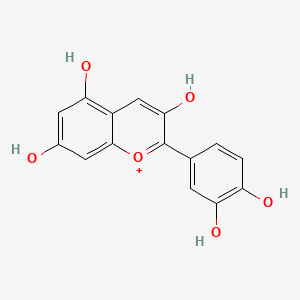| MeSH term | MeSH ID | Detail |
|---|---|---|
| Colonic Neoplasms | D003110 | 161 associated lipids |
| Edema | D004487 | 152 associated lipids |
| Glioma | D005910 | 112 associated lipids |
| Tooth Discoloration | D014075 | 7 associated lipids |
| Psoriasis | D011565 | 47 associated lipids |
| Wound Infection | D014946 | 12 associated lipids |
| Nerve Degeneration | D009410 | 53 associated lipids |
Cyanidin
Cyanidin is a lipid of Polyketides (PK) class. Cyanidin is associated with abnormalities such as Consumption-archaic term for TB, furuncle, Obesity, Cardiovascular Diseases and Endothelial dysfunction. The involved functions are known as anthocyanin biosynthetic process, Regulation, flavonoid biosynthetic process, Anabolism and anthocyanin metabolic process. Cyanidin often locates in Body tissue, integral to membrane, Autonomic nervous system, Blood and Tissue membrane. The associated genes with Cyanidin are anthocyanidin synthase, SLC2A8 gene, EPB41L2 gene, NKS1 gene and GLUCOSIDASE. The related lipids are Butanols. The related experimental models are Knock-out.
Cross Reference
Introduction
To understand associated biological information of Cyanidin, we collected biological information of abnormalities, associated pathways, cellular/molecular locations, biological functions, related genes/proteins, lipids and common seen animal/experimental models with organized paragraphs from literatures.
What diseases are associated with Cyanidin?
Cyanidin is suspected in Obesity, Chronic Disease, Diabetes Mellitus, Non-Insulin-Dependent, Cardiovascular Diseases, Heart Diseases, Inflammatory disorder and other diseases in descending order of the highest number of associated sentences.
Related references are mostly published in these journals:
| Disease | Cross reference | Weighted score | Related literature |
|---|
Possible diseases from mapped MeSH terms on references
We collected disease MeSH terms mapped to the references associated with Cyanidin
PubChem Associated disorders and diseases
What pathways are associated with Cyanidin
There are no associated biomedical information in the current reference collection.
PubChem Biomolecular Interactions and Pathways
Link to PubChem Biomolecular Interactions and PathwaysWhat cellular locations are associated with Cyanidin?
Visualization in cellular structure
Associated locations are in red color. Not associated locations are in black.
Related references are published most in these journals:
| Location | Cross reference | Weighted score | Related literatures |
|---|
What functions are associated with Cyanidin?
Related references are published most in these journals:
| Function | Cross reference | Weighted score | Related literatures |
|---|
What lipids are associated with Cyanidin?
Related references are published most in these journals:
| Lipid concept | Cross reference | Weighted score | Related literatures |
|---|
What genes are associated with Cyanidin?
Related references are published most in these journals:
| Gene | Cross reference | Weighted score | Related literatures |
|---|
What common seen animal models are associated with Cyanidin?
Knock-out
Knock-out are used in the study 'MATE2 mediates vacuolar sequestration of flavonoid glycosides and glycoside malonates in Medicago truncatula.' (Zhao J et al., 2011) and Knock-out are used in the study 'How can research on plants contribute to promoting human health?' (Martin C et al., 2011).
Disease model
Disease model are used in the study 'How can research on plants contribute to promoting human health?' (Martin C et al., 2011).
Animal Disease Models
Animal Disease Models are used in the study 'How can research on plants contribute to promoting human health?' (Martin C et al., 2011).
Related references are published most in these journals:
| Model | Cross reference | Weighted score | Related literatures |
|---|
NCBI Entrez Crosslinks
All references with Cyanidin
Download all related citations| Authors | Title | Published | Journal | PubMed Link |
|---|---|---|---|---|
| Grajeda-Iglesias C et al. | Isolation and Characterization of Anthocyanins from Hibiscus sabdariffa Flowers. | 2016 | J. Nat. Prod. | pmid:27312226 |
| Marques C et al. | Pharmacokinetics of blackberry anthocyanins consumed with or without ethanol: A randomized and crossover trial. | 2016 | Mol Nutr Food Res | pmid:27306520 |
| Camelo-Méndez GA et al. | Effect on in vitro starch digestibility of Mexican blue maize anthocyanins. | 2016 | Food Chem | pmid:27283633 |
| Santos FT et al. | Comparison of five agro-industrial waste-based composts as growing media for lettuce: Effect on yield, phenolic compounds and vitamin C. | 2016 | Food Chem | pmid:27173566 |
| Sigurdson GT et al. | Evaluating the role of metal ions in the bathochromic and hyperchromic responses of cyanidin derivatives in acidic and alkaline pH. | 2016 | Food Chem | pmid:27132820 |
| Feng C et al. | Antioxidant capacities and anthocyanin characteristics of the black-red wild berries obtained in Northeast China. | 2016 | Food Chem | pmid:26988488 |
| Nankar AN et al. | Quantitative and qualitative evaluation of kernel anthocyanins from southwestern United States blue corn. | 2016 | J. Sci. Food Agric. | pmid:26879128 |
| Singh CK et al. | Combination chemoprevention with grape antioxidants. | 2016 | Mol Nutr Food Res | pmid:26829056 |
| Pantelić MM et al. | Identification and quantification of phenolic compounds in berry skin, pulp, and seeds in 13 grapevine varieties grown in Serbia. | 2016 | Food Chem | pmid:27283628 |
| Lai YS et al. | The Dark-Purple Tea Cultivar 'Ziyan' Accumulates a Large Amount of Delphinidin-Related Anthocyanins. | 2016 | J. Agric. Food Chem. | pmid:26996195 |
